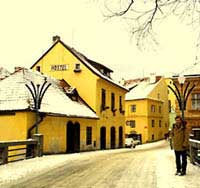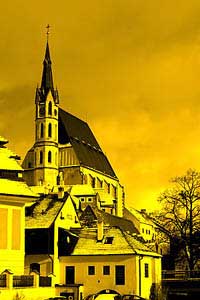|
t r a v e l s n a p zT r a v e l t h e w o r l d f o r j u s t a f e w c l i c k s |
||||
Postcard from Cesky Krumlov on TravelSnapz |
||||

A hostel building in the heart of Cesky Krumlov. |
No dumpling deprivation at Cesky Krumlov!Once upon a time, a long, long time ago…. well that is how most fairy tales begin - but this is not a fairy tale, rather it is a story about a fairy tale town.Ceský Krumlov is tucked into a crook in the River Vltava, long before it reaches Prague. Here the river is fast flowing, but it took the time to bend and make a special place for Ceský Krumlov.When the river gets to Ceský Krumlov, it takes a hard left (all fairies are left-handed) and then is forced to bend back on itself by the high towers of the mansion and castle complex of Krumlov. The old village of Ceský Krumlov sits in this fairy's teardrop (a teardrop of joy no doubt). Maybe the need for a town to service the Krumlov mansion is why Ceský Krumlov is what it is today, maybe it was not because of the fairies at all - but whatever it was, it was good enough to put Ceský Krumlov on the UNESCO world heritage list in 1992. And what a treasure Ceský Krumlov is. Picturesque street facades, well-preserved castle and mansion buildings, interesting local artefacts, good restaurants, plenty of well presented accommodation, flora and fauna; and all surrounded by lovely rolling hills and the gentle bubbling of the charming River Vltava (or is that the fairies talking). The mansion and castle complex, comprising over forty buildings, has been the seat of many important families over the centuries. They have bought the local area fame and (at times) fortune as they developed the mansion, sponsored the arts and gave the townsfolk special privileges. One of the most noticeable features of
the mansion is the tower that rises up to complement the spire of
St Vitus standing in the middle of the town on the other side of
the river. The tower has a special arcaded gallery for buglers,
below which is a ring of human and animal masks. |

St Vitus Church is right in the centre of the town. |
Things you should see inside the mansion complex include the Chapel of St George, the Masquerade Hall, the Mirror Hall and the unique Baroque theatre with scenery, costumes and lighting equipment dating back to the 1700's. And of course we must not forget the bears. Currently three (soon to be four - those fairies have been up to their tricks again) bears are housed in the bear pits either side of the arched doorway to the first courtyard. Below the entrance to the first courtyard of the castle and overlooked by the tower are the old stables, you will find the burgomaster's house, the ice house, the smithy and other buildings and storage areas that were needed to ensure the proper functioning of the mansion complex. Nearby is a section of the old town that sits on the castle side of the river, where castle servants and artisans once lived. This area now provides sustenance and trinkets to the new providers of wealth - the many tourists that visit the area. The history of the families that lived in the Ceský Krumlov mansion is interesting. The castle complex was first established by the powerful Vitkovec family and Krumlov, as it was then called - the word Ceský (meaning Czech) was not added until the 15th Century - is first mentioned in official documentation in 1253. In 1302, the mansion and castle complex was inherited by the Rosenberg family and they set to work extending and enhancing the complex over the 300 years of their reign. The Rosenbergs had their family seat in the mansion and because of their importance, a court atmosphere was established; this brought economic benefits to the district. It was during this time that the main village was established, churches were built, town services were put in place and citizen rights were granted. The Rosenbergs eventually ran out of money and the mansion and castle complex was sold to Emperor Rudolph II. Rudolph's base was in Prague, so the complex stagnated for a while. Ownership eventually passed onto another family, the Eggenbergs (who established the formal garden), and then to the Swarzenbergs, who brought some importance back to the area and a rebuilding program to the mansion which included the Baroque theatre. As these families came and went, the village of Krumlov grew and spilled over from the castle side of the river to the opposite bank. This is where the main part of the old village is now established. You cross over to this part of the Ceský Krumlov village by an old wooden bridge. It is worth glancing over your shoulder as you cross the bridge, past the statues to the magnificent castle tower. You can walk up Radnicni Street direct to the town square, or you can divert along Dlouhá Street - whichever way you will pass the old facades that give the village its fairy tale appeal. The town square has a central plague column erected in thanks by those that were spared the ravages of the Black Death. Around the square attractive facades are a tribute to ancient architects. From here you can walk up Horni Street past the Hotel Ruže (formerly a Jesuit College until 1775) to the well-appointed museum. |
Cesky Krumlov |
The museum has four floors of excellent displays which trace the history of the region. It includes some ethnographic displays and an interesting model of old Ceský Krumlov, so it's probably a good place to start your visit to the town to get an understanding of the local culture and traditions. You could spend a day just wandering the village streets, inspecting the charming local lace work and other souvenirs, looking through the impressively positioned St Vitus Church; across another wooden bridge to the park that surrounds St Martins Chapel with its modern art structures, and by then it would be time for a meal in a good restaurant. One of the many restaurants of note is Don Julius, named after the bastard son of Emperor Rudolph II, who was once a resident of the castle and who, it is told, caused several of the town's maidens to believe in fairies. Don Julius has unusual décor, including the front of a car bulging from a wall (the headlights will help you read the extensive menu), and a toy train that whistles and shunts its way on a track suspended overhead (don't worry, the warning bells work), and the cuisine is excellent. You will not suffer from dumpling deprivation here. Finding a bed for the night will not be a problem (but in summer you would be wise to book). You can chose from a range of top-class hotels or move down through the stars to the pensions and then to the hostels. One of the pensions is housed in an old defence tower and the rooms have interesting shapes. |
 |
The town stages a number of festivals through the summer months, including the Festival of the Five Petalled Rose (the emblem of the Rosenbergs who used the castle as their family seat from 1302 to 1602), a piano festival and an international music festival. If you tire of the town's architecture, there are plenty of walks through the surrounding countryside to occupy the energetic and a number of trails are signposted. There are boats, and bicycles to be hired (for the even more energetic) or you could get a fishing license and just while away the time on the banks of the Vltava River. If you need help, the good fairies at the Ceský Krumlov information centre can assist you with accommodation services, restaurant reservations, cars, boats, horses or bikes, tickets for festival events, maps, guides and anything else a fairy can do (within reason). And you don't need to find a ring of toadstools to get in touch, just close your eyes, click your mouse, and go infocentrum@ckrf.ckrumlov.cz . More Photos of Cesky Krumlov |
 Above the
buglers arcade there is a clock and a belltower section. The
tower area of the castle complex dates back to the 13th Century
and since that time various owners have developed buildings and
courtyards further up the rocky spur to the large formal 17th
Century walled garden area that sits on top of the hill. In
winter you can make the icy, slippery walk up through the castle
courtyards and peer through the locked gates at the snow-covered
garden, but in summer the mansion rooms and garden are open to
visitors.
Above the
buglers arcade there is a clock and a belltower section. The
tower area of the castle complex dates back to the 13th Century
and since that time various owners have developed buildings and
courtyards further up the rocky spur to the large formal 17th
Century walled garden area that sits on top of the hill. In
winter you can make the icy, slippery walk up through the castle
courtyards and peer through the locked gates at the snow-covered
garden, but in summer the mansion rooms and garden are open to
visitors. Cesky Krumlov
Cesky Krumlov